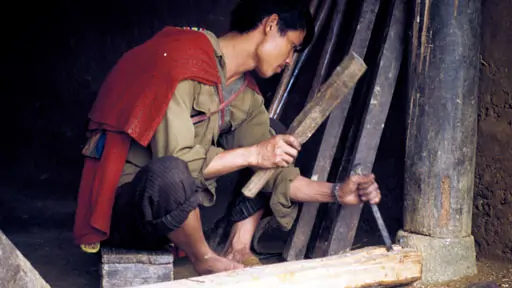Indigenous Calendar October, 2012: Traditional Techniques Create Homogenous Hmong Houses

Throughout Southeast Asia stark contrasts can be found around every corner. A theologian can watch an ancient, Animistic ritual being performed from the vantage point of a Buddhist, hilltop pagoda. A tourist witnesses hungry street children in tattered clothes begging in the business districts of the region's economic "tigers" in Kuala Lumpur, Bangkok and Ho Chi Minh City. A musician will fail to identify strange musical instruments lying next to CDs of Western pop artists. And a fashion designer would balk at the Nike baseball cap being worn, backwards, by the boy who is otherwise dressed according to the traditional, centuries-old clothing of his people.
Possibly the country with the most contrasts is the Lao People's Democratic Republic. It is still officially a communist country and the visitor sees everywhere the legacy of its 1970s liberator — the former Soviet Union. For example, ten-meter high, Stalinist murals depict the "struggle of the working people" and are crowned by the Hammer and Sickle emblem. There are probably more sites like this per square kilometer in the Lao PDR than there are in the former Soviet Union itself! Yet in the Lao PDR, as in Vietnam, Cuba and, to some extent China, private enterprise is emerging alongside the official system.
Despite these contrasts many aspects of people's life appear homogenous — particularly across the dozens of indigenous peoples who live there. Agriculture is their main livelihood and indigenous languages are still spoken.
It was during my first visit to the Lao PDR that I experienced these contrasts. To my surprise I found homogeneity where I least expected it. Dwellings have, until very recently, been constructed from locally available resources. Southeast Asia is a diverse region in terms of its topography and climate, which makes for equal diversity in the plant species that are indigenous to each area. Yet everywhere the dwellings of the indigenous peoples looked the same to me. Then when I wandered out to a remote Hmong village and saw a scene very similar to this man (photographed in neighboring Thailand) constructing his new home for his wife and future family I finally realized why and how I had missed the obvious: the construction techniques they use have not altered much over thousands of years.
The Hmong are featured in our documentary, Indigenous Peoples of Southeast Asia.
If you enjoyed reading this article, please consider supporting independent, advertising-free journalism by buying us a coffee to help us cover the cost of hosting our web site. Please click on the link or scan the QR code. Thanks!


